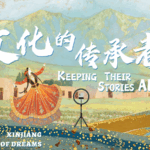In the Xinjiang Uygur Autonomous Region, where nomadic traditions have largely faded into memory, Hatima Ainaidou threads a vibrant connection to her Kazakh heritage. The 48-year-old entrepreneur and municipal-level inheritor of Kazakh embroidery has spent over two decades transforming ancient stitches into a living legacy.
At her workshop in Urumqi County, Hatima preserves a 2,000-year-old craft once vital to Kazakh identity. "Embroidery wasn't just decoration—it was our language," she explains. "From yurt tapestries to wedding dowries, these patterns told stories of our people."
Once considered essential for marriage—"No embroidery skills meant no husband," Hatima recalls with a smile—the craft now faces modern challenges. Through her company, she trains younger artisans while adapting traditional motifs for contemporary home decor and fashion.
The art form's evolution mirrors Xinjiang's development: Deer-skin saddle decorations have given way to silk scarves sold in urban boutiques, yet each piece maintains symbolic patterns of mountains and eagles central to Kazakh culture. "Every stitch honors my grandmother's hands," says Hatima, whose maternal lineage passed down the craft through generations.
As China works to protect intangible cultural heritage, practitioners like Hatima demonstrate how traditional skills can thrive in modern markets. Her workshops now attract both local residents and international buyers, weaving economic opportunity into cultural preservation.
Reference(s):
cgtn.com






